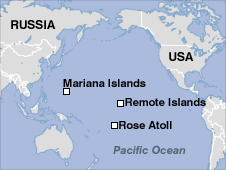
On January 6, 2009, President George Bush signed a proclamation “to protect three beautiful and biologically diverse areas of the Pacific Ocean as new Marine National Monuments”. President Bush enacted the preservation of these three regions, which will make up the largest area of ocean set aside for marine conservation in the world (195,280 sq. miles), using the 1906 Antiquities Act. This Act was first used by President Theodore Roosevelt to set aside public lands such as the Grand Canyon as national monuments. Many of the areas created under the act were later acknowledged as national parks.
Additionally, Bush announced that the United States will submit a request to establish George Washington's Virginia home, Mount Vernon, and the Northwestern Hawaiian Islands Marine National Monument as UNESCO world heritage sites. Although, environmentalists haven’t been first in line to praise Bush for the past eight years they are welcoming his current support and enthusiasm for environmental and historical preservation.

The Marines Conservation Biology Institute and the Environmental Defense Fund partnered to identify eight of the nine sites that the President identified for preservation. The identified areas; Rose Atoll, Wake Island, Johnston Island, Palmyra Island, King Reef, Baker Island, Howland Island, and Jarvis Island. Noting the intent for preservation Bush provided gravity to the decision, "For sea birds and marine life, they will be sanctuaries to grow and thrive. For scientists, they will be places to extend the frontiers of discovery. And for the American people, they will be places that honor our duty to be good stewards of the Almighty's creation."
All but one of these eight remote areas have Fish and Wildlife Service refuge areas at their cores. Rose Atoll, is the smallest atoll in the world yet it supports 97 percent of America Samoa’s seabird population, is a nesting ground for several threatened turtle populations and has more than 500 fish species that swim and thrive in the surrounding waters. The Pew Environmental Fund identified the ninth site: the waters around the northern Marianas and the deepest ocean canyon in the world, the Mariana Trench, 11,033 meters (36,201 feet) at its deepest. This unique site claims the deepest point on earth. It is more than five times longer than the Grand Canyon and deeper than Mt. Everest is tall. As rare earthly treasure it is scattered and surrounded with hydrothermal vents, undersea volcanoes, and it is the only known location of liquid sulfur this side of Jupiter.
The new designations will expand protection to a 50 nautical mile area off the islands. Commercial fishing will be prohibited but with a permit recreational fishing will be allowed in moderation. This is certainly a promising step on America’s behalf to begin to work more closely with UNESCO and like organization to perverse the environment, historical sites, and culture.
Watch Bush dedicate the central Pacific sites »
No comments:
Post a Comment